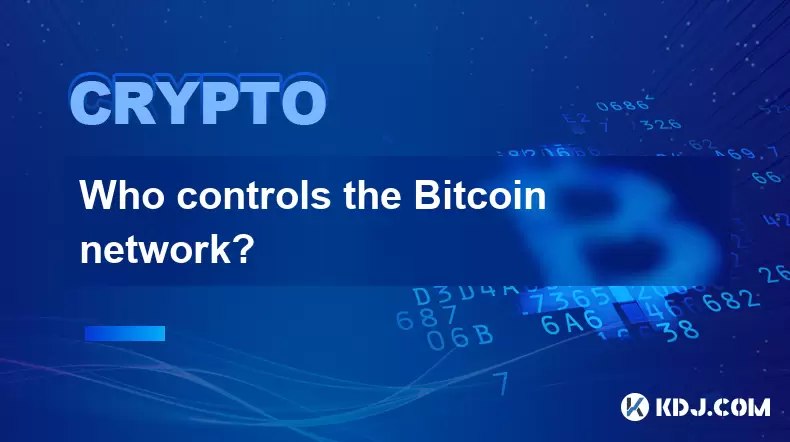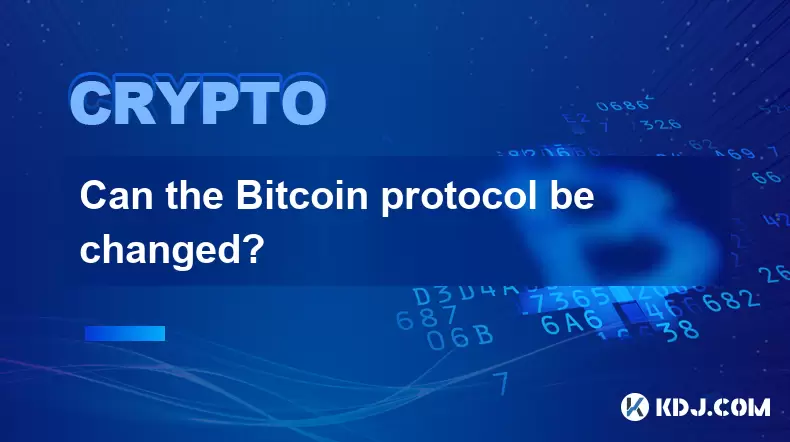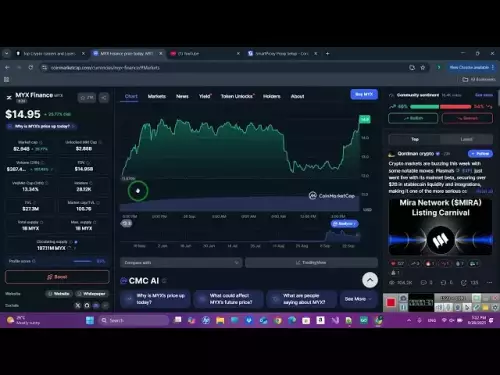-
 bitcoin
bitcoin $109547.008142 USD
0.04% -
 ethereum
ethereum $4011.838726 USD
-0.05% -
 tether
tether $1.000402 USD
-0.01% -
 xrp
xrp $2.798606 USD
0.88% -
 bnb
bnb $970.877944 USD
1.39% -
 solana
solana $202.237275 USD
-0.95% -
 usd-coin
usd-coin $0.999673 USD
0.00% -
 dogecoin
dogecoin $0.229294 USD
-1.15% -
 tron
tron $0.336370 USD
-0.45% -
 cardano
cardano $0.777260 USD
-1.66% -
 hyperliquid
hyperliquid $45.503019 USD
1.73% -
 ethena-usde
ethena-usde $1.000362 USD
0.01% -
 chainlink
chainlink $20.785303 USD
-1.10% -
 avalanche
avalanche $28.755822 USD
-0.11% -
 stellar
stellar $0.358303 USD
-0.48%
Who controls the Bitcoin network?
Bitcoin's decentralized network relies on miners, developers, full nodes, and users working together to maintain security, validate transactions, and guide its evolution without central control.
Jul 07, 2025 at 06:35 pm

Understanding the Decentralized Nature of Bitcoin
The Bitcoin network operates on a decentralized framework, which means it is not controlled by any single individual, organization, or government. Unlike traditional financial systems where central banks or regulatory bodies have authority over monetary policy and transaction validation, Bitcoin's design ensures that no one entity holds control. Instead, it relies on a distributed consensus mechanism known as Proof of Work (PoW).
At the core of this system are miners, who use computational power to validate transactions and secure the network. Each block added to the blockchain must be verified by a majority of nodes, ensuring transparency and security. The decentralized nature of Bitcoin makes it resistant to censorship and tampering, reinforcing its foundational principle of peer-to-peer electronic cash without intermediaries.
The Role of Miners in Network Governance
Miners play a crucial role in maintaining the integrity of the Bitcoin network. They confirm transactions by solving complex cryptographic puzzles, a process known as mining. When a miner successfully validates a block, it is broadcasted to the rest of the network for acceptance. If the majority of nodes agree that the block is valid, it gets added to the blockchain.
However, even though miners contribute to transaction validation, they do not dictate the rules of the protocol. Their influence is limited to choosing which blocks to mine and which transactions to include. Any attempt to alter the underlying rules—such as increasing the block reward beyond the set limit—would result in rejection by the rest of the network. Therefore, while miners are essential for processing transactions, they do not control Bitcoin in the broader sense.
How Developers Influence Bitcoin’s Protocol
Developers are responsible for proposing changes to the Bitcoin protocol, but their role should not be mistaken for control. Open-source software allows anyone to review, modify, and suggest improvements to the codebase. The most widely used implementation, Bitcoin Core, is maintained by a group of developers who work collaboratively to enhance the network’s functionality and security.
Despite their technical expertise, developers cannot enforce changes unilaterally. Any proposed upgrade, such as a soft fork or hard fork, must gain consensus from the broader community—including miners, node operators, wallet providers, and users. Without widespread agreement, a change will not be adopted. This ensures that no developer has unilateral authority over Bitcoin’s direction.
The Function of Full Nodes in Maintaining Consensus
Full nodes are another critical component of the Bitcoin network. These are computers that fully validate all transactions and blocks according to the established consensus rules. Running a full node allows individuals to independently verify the state of the blockchain without relying on third parties.
Anyone can run a full node, and doing so strengthens the network by enforcing compliance with the protocol. If a miner attempts to submit an invalid block, full nodes reject it, preserving the integrity of the system. Because full nodes operate autonomously and collectively, they serve as a check against malicious actors. Thus, full nodes act as guardians of Bitcoin’s decentralized structure.
User Adoption and Economic Influence on Bitcoin
Ultimately, users determine the value and adoption of Bitcoin. While developers write the code and miners secure the network, it is the users who decide whether to accept a particular version of Bitcoin. If a proposed change is unpopular, users may choose to support an alternative chain or reject the update altogether.
Economic activity also plays a significant role in shaping the network. Exchanges, merchants, and investors contribute to Bitcoin’s liquidity and usability. If a majority of users lose confidence in a specific implementation, its market value may decline, rendering it irrelevant. Therefore, user behavior and economic incentives serve as powerful tools in influencing the long-term viability and governance of Bitcoin.
Frequently Asked Questions
- Can governments shut down the Bitcoin network?While governments can regulate or restrict access to Bitcoin within their jurisdictions, they cannot shut down the entire network due to its decentralized and global nature.
- What happens if a majority of miners collude?If a group of miners controls more than 50% of the network’s hash power, they could potentially launch a double-spending attack. However, such an action would undermine trust in Bitcoin and likely devalue their own holdings, making it economically irrational.
- Who decides when Bitcoin undergoes an upgrade?Upgrades require consensus among various stakeholders including developers, miners, node operators, and users. No single party can impose changes without broad agreement.
- Is there a central authority behind Bitcoin wallets?No, Bitcoin wallets are typically non-custodial and open-source. Users retain full control over their private keys, and no centralized body governs wallet operations.
Disclaimer:info@kdj.com
The information provided is not trading advice. kdj.com does not assume any responsibility for any investments made based on the information provided in this article. Cryptocurrencies are highly volatile and it is highly recommended that you invest with caution after thorough research!
If you believe that the content used on this website infringes your copyright, please contact us immediately (info@kdj.com) and we will delete it promptly.
- BlockchainFX, Binance Coin, Cardano: Decoding the Crypto Landscape in 2025
- 2025-09-29 04:45:12
- Cathie Wood, Bitcoin, and the Future of Monetary Standards: A New York Perspective
- 2025-09-29 04:25:17
- Crypto Presales Under the Microscope: BlockDAG, HYPER, and the Hunt for the Next Big Thing
- 2025-09-29 04:25:17
- Ethereum Bulls Eye $4,000: Is the Rally Sustainable?
- 2025-09-29 05:05:14
- Aster Price Surge: Bullish Breakout or Falling Wedge Fiasco?
- 2025-09-29 04:45:12
- Aptos Price Prediction: Will the Velociraptor Upgrade Trigger a Rally?
- 2025-09-29 04:50:01
Related knowledge

Why is Bitcoin considered a revolutionary technology?
Aug 12,2025 at 08:29pm
Decentralization and the Elimination of Central AuthoritiesThe core innovation behind Bitcoin lies in its decentralized architecture, which fundamenta...

Why is Bitcoin considered a revolutionary technology?
Aug 10,2025 at 07:42pm
Decentralized Architecture and Trustless TransactionsBitcoin is considered revolutionary because it introduced a decentralized architecture that opera...

What are the key features of Bitcoin?
Aug 10,2025 at 02:50am
Decentralization and Peer-to-Peer NetworkOne of the most defining characteristics of Bitcoin is its decentralized nature. Unlike traditional financial...

Can the Bitcoin protocol be changed?
Aug 07,2025 at 01:16pm
Understanding the Bitcoin ProtocolThe Bitcoin protocol is the foundational set of rules that govern how the Bitcoin network operates. It defines every...

Can the Bitcoin protocol be changed?
Aug 11,2025 at 01:01am
Understanding the Bitcoin Protocol StructureThe Bitcoin protocol is the foundational set of rules that govern how the Bitcoin network operates. These ...

What happens to Bitcoin transactions once they are confirmed?
Aug 09,2025 at 05:22am
Understanding Bitcoin Transaction ConfirmationWhen a Bitcoin transaction is initiated, it is broadcast to the network and placed in a pool of unconfir...

Why is Bitcoin considered a revolutionary technology?
Aug 12,2025 at 08:29pm
Decentralization and the Elimination of Central AuthoritiesThe core innovation behind Bitcoin lies in its decentralized architecture, which fundamenta...

Why is Bitcoin considered a revolutionary technology?
Aug 10,2025 at 07:42pm
Decentralized Architecture and Trustless TransactionsBitcoin is considered revolutionary because it introduced a decentralized architecture that opera...

What are the key features of Bitcoin?
Aug 10,2025 at 02:50am
Decentralization and Peer-to-Peer NetworkOne of the most defining characteristics of Bitcoin is its decentralized nature. Unlike traditional financial...

Can the Bitcoin protocol be changed?
Aug 07,2025 at 01:16pm
Understanding the Bitcoin ProtocolThe Bitcoin protocol is the foundational set of rules that govern how the Bitcoin network operates. It defines every...

Can the Bitcoin protocol be changed?
Aug 11,2025 at 01:01am
Understanding the Bitcoin Protocol StructureThe Bitcoin protocol is the foundational set of rules that govern how the Bitcoin network operates. These ...

What happens to Bitcoin transactions once they are confirmed?
Aug 09,2025 at 05:22am
Understanding Bitcoin Transaction ConfirmationWhen a Bitcoin transaction is initiated, it is broadcast to the network and placed in a pool of unconfir...
See all articles










































































